Experimental Study on Shear Capacity of Reinforced Concrete Beams with Corroded Longitudinal Reinforcement
Abstract
:1. Introduction
2. Experimental Program
2.1. Test Specimens
2.2. Accelerated Corrosion Technique
2.3. Shear Test Set-Up
3. Experimental Results
3.1. Accelerated Corrosion Test Results
3.2. Failure Modes of Test Specimens
3.3. Shear Behaviors of Test Specimens
3.4. Measured Strains of Stirrups
4. Discussion
5. Conclusions
- The actual corrosion rate introduced into the tension reinforcement of the specimens differed from the corrosion rate calculated using Faraday’s law. This is because the corrosion products caused by the progress of the reinforcement corrosion interfere with the supplies of oxygen (O2) and water (H2O) necessary to form the corrosion cell, and the magnitude of the current density () used in the accelerated corrosion test is considerably large. Therefore, to obtain the target corrosion rate in the test, using a small current density ranging from to is desirable.
- In the TS series specimens in which the tension reinforcement has not been properly anchored at the ends of the members, the shear capacity of the TS-3 specimen ( = 1.14%) with a small corrosion rate increased by 18% as compared to that of the TS-0 specimen. This is due to the bond performance of reinforcement that improves at a low corrosion rate of less than 2%. However, the TS-8 ( = 4.13%) and TS-15 ( = 9.76%) specimens with high corrosion rates showed 11% and 30% reduced shear capacities, respectively, as compared to the reference specimen. This is attributed to the detrimental effect of the bond loss caused by the corrosion of longitudinal reinforcement on the shear capacities of the members.
- In the TH series specimens in which the tension reinforcement had been properly anchored at the ends of the members, the shear capacities of the corroded specimens with low corrosion rates as well as those with high corrosion rates were higher than that of the reference specimen. In particular, even the TH-15 specimen ( = 8.82%), which had the highest corrosion rate, showed an increased capacity of about 8% as compared to the TH-0 specimen. This is because, despite a reduction in the bond performance between corroded reinforcement and concrete, the load transfer mechanism changes from beam action to arch action as the reinforcement has been properly anchored at the ends of the member.
- The ACI 318-14 code equations overestimated the shear capacities of the corroded specimens and did not provide good predictions over the shear capacity changes of the test specimens in accordance with the corrosion rates. This suggests that the influence of a reduction in bond performance on the shear capacity is more significant than that of a decrease in the sectional area of tension reinforcement due to corrosion.
- The STM, which reflects the arch-action mechanism, overestimated the shear capacities of the corroded specimens because it failed to reflect the reduction of bond performance between corroded reinforcement and concrete. Therefore, further research is still required to clearly understand the shear capacity of corroded RC members with proper anchorage details, based on which a more proper method to reflect the bond performance of the tension reinforcement due to corrosion can be developed.
- The research findings of this study indicate that the anchorage details are very important to keep the shear capacity of RC members exposed to deterioration environment.
Author Contributions
Funding
Conflicts of Interest
References
- Liu, Y.; Weyers, R.E. Modeling the time-to-corrosion cracking in chloride contaminated reinforced concrete structures. ACI Mater. J. 1998, 95, 675–681. [Google Scholar] [CrossRef]
- Oh, B.H.; Kim, K.H.; Jang, B.S. Critical corrosion amount to cause cracking of reinforced concrete structures. ACI Mater. J. 2009, 106, 333–339. [Google Scholar] [CrossRef]
- Hanjari, K.Z.; Kettil, P.; Lundgren, K. Analysis of mechanical behavior of corroded reinforced concrete structures. ACI Struct. J. 2011, 108, 532–541. [Google Scholar] [CrossRef]
- Kim, K.H.; Jang, S.Y.; Jang, B.S.; Oh, B.H. Modeling mechanical behavior of reinforced concrete due to corrosion of steel bar. ACI Mater. J. 2010, 107, 106–113. [Google Scholar] [CrossRef]
- Han, S.J.; Lee, D.H.; Kim, K.S.; Seo, S.Y.; Moon, J.; Paulo, P.J.M. Degradation of flexural strength in reinforced concrete members caused by steel corrosion. Constr. Build. Mater. 2014, 54, 572–583. [Google Scholar] [CrossRef]
- Chung, L.; Cho, S.H.; Kim, J.H.J.; Yi, S.T. Correction factor suggestion for ACI development length provisions based on flexural testing of RC slabs with various levels of corroded reinforcing bars. Eng. Struct. 2004, 26, 1013–1026. [Google Scholar] [CrossRef]
- Chung, L.; Najm, H.; Balaguru, P. Flexural behavior of concrete slabs with corroded bars. Cem. Concr. Compos. 2008, 30, 184–193. [Google Scholar] [CrossRef]
- Al-Sulaimani, G.J.; Kaleemullah, M.; Basunbul, I.A. Influence of corrosion and cracking on bond behavior and strength of reinforced concrete members. ACI Struct. J. 1990, 87, 220–231. [Google Scholar] [CrossRef]
- Azad, A.K.; Ahmad, S.; Azher, S.A. Residual strength of corrosion-damaged reinforced concrete beams. ACI Mater. J. 2007, 104, 40–47. [Google Scholar] [CrossRef]
- Maaddawy, T.E.; Soudki, K.; Topper, T. Long-term performance of corrosion-damaged reinforced concrete beams. ACI Struct. J. 2005, 102, 649–659. [Google Scholar] [CrossRef]
- Almusallam, A.A.; Al-Gahtani, A.S.; Aziz, A.R.; Dakhill, F.H. Effect of reinforcement corrosion on flexural behavior of concrete slabs. J. Mater. Civil Eng. 1996, 8, 123–127. [Google Scholar] [CrossRef]
- Wang, X.H.; Liu, X.L. Modeling effects of corrosion on cover cracking and bond in reinforced concrete. Mag. Concr. Res. 2004, 56, 191–199. [Google Scholar] [CrossRef]
- Maaddawy, T.E.; Soudki, K. Analytical Model to Predict Nonlinear Flexural Behavior of Corroded Reinforced Concrete Beams. ACI Struct. J. 2005, 102, 550–559. [Google Scholar] [CrossRef]
- Higgins, C.; Farrow, W.C. Tests of reinforced concrete beams with corrosion damaged stirrups. ACI Struct. J. 2006, 103, 133–141. [Google Scholar] [CrossRef]
- Zhao, Y.; Chen, J.; Kin, W. Design of shear strengths of corroded reinforced concrete beams. Int. J. Model. Ident. Control 2009, 7, 190–198. [Google Scholar] [CrossRef]
- EI-Sayed, A.K. Shear capacity assessment of reinforced concrete beams with corroded stirrups. Constr. Build. Mater. 2017, 134, 176–184. [Google Scholar] [CrossRef]
- Azam, R.; Soudki, K. Structural behavior of shear-critical RC slender beams with corroded properly anchored longitudinal steel reinforcement. J. Struct. Eng. 2013, 139, 04013011. [Google Scholar] [CrossRef]
- Azam, R.; Soudki, K. Structural performance of shear-critical RC deep beams with corroded longitudinal steel reinforcement. Cem. Concr. Compos. 2012, 34, 946–957. [Google Scholar] [CrossRef]
- Jeppsson, J.; Thelandersson, S. Behavior of reinforced concrete beams with loss of bond at longitudinal reinforcement. J. Struct. Eng. 2003, 129, 1376–1383. [Google Scholar] [CrossRef]
- Toongoenthong, K.; Maekawa, K. Interaction of pre-induced damages along main reinforcement and diagonal shear in RC members. J. Adv. Concr. Technol. 2004, 2, 431–443. [Google Scholar] [CrossRef]
- Lachemi, M.; Al-Bayati, N.; Sahmaran, M.; Anil, O. The effect of corrosion on shear behavior of reinforced self-consolidating concrete beams. Eng. Struct. 2014, 79, 1–12. [Google Scholar] [CrossRef]
- Xue, X.; Seki, H. Influence of longitudinal bar corrosion on shear behavior of RC beams. J. Adv. Concr. Technol. 2010, 8, 145–156. [Google Scholar] [CrossRef]
- Hwang, J.H.; Lee, D.H.; Park, M.K.; Choi, S.H.; Kim, K.S.; Pan, Z. Shear performance assessment of steel fiber reinforced prestressed concrete members. Comput. Concr. 2015, 16, 825–846. [Google Scholar] [CrossRef]
- Hwang, J.H.; Lee, D.H.; Ju, H.; Kim, K.S.; Kang, T.H.K.; Pan, Z. Shear deformation of steel fiber-reinforced prestressed concrete beams. Int. J. Concr. Struct. Mater. 2016, 10, 53–63. [Google Scholar] [CrossRef]
- ACI Committee 318. Building Code Requirements for Structural Concrete (ACI 318M-14) and Commentary; American Concrete Institute: Farmington Hills, MI, USA, 2014; 519p. [Google Scholar]
- Andrade, C.; Alonso, C.; Molina, F.J. Cover cracking as a function of bar corrosion: Part 1—Experimental test. Mater. Struct. 1993, 26, 453–464. [Google Scholar] [CrossRef]
- Al-Hearthy, A.; Stewart, M.G.; Mullard, J. Concrete cover cracking caused by steel reinforcement corrosion. Mag. Concr. Res. 2011, 63, 655–667. [Google Scholar] [CrossRef]
- Maaddawy, T.E.; Soudki, K. Effectiveness of impressed current technique to simulate corrosion of steel reinforcement in concrete. J. Mater. Civ. Eng. 2003, 15, 41–47. [Google Scholar] [CrossRef]
- Lin, H.; Zhao, Y. Effects of confinements on the bond strength between concrete and corroded steel bars. Constr. Build. Mater. 2016, 118, 127–138. [Google Scholar] [CrossRef]
- ASTM. Standard Practice for Preparing, Cleaning, and Evaluating Corrosion Test Specimens; ASTM G1-03; ASTM: West Conshohocken, PA, USA, 2011. [Google Scholar]
- Cabrera, J.G. Deterioration of concrete due to reinforcement steel corrosion. Cem. Concr. Compos. 1996, 18, 47–59. [Google Scholar] [CrossRef]
- Ombres, L.; Verre, S. Shear performance of FRCM strengthened RC beams. ACI Special Publ. 2018, 324, 7. [Google Scholar]
- Cascardi, A.; Aiello, M.A.; Triantafillou, T. Analysis0oriented model for concrete and masonry confined with fiber reinforced mortar. Mater. Struct. 2017, 50, 202. [Google Scholar] [CrossRef]


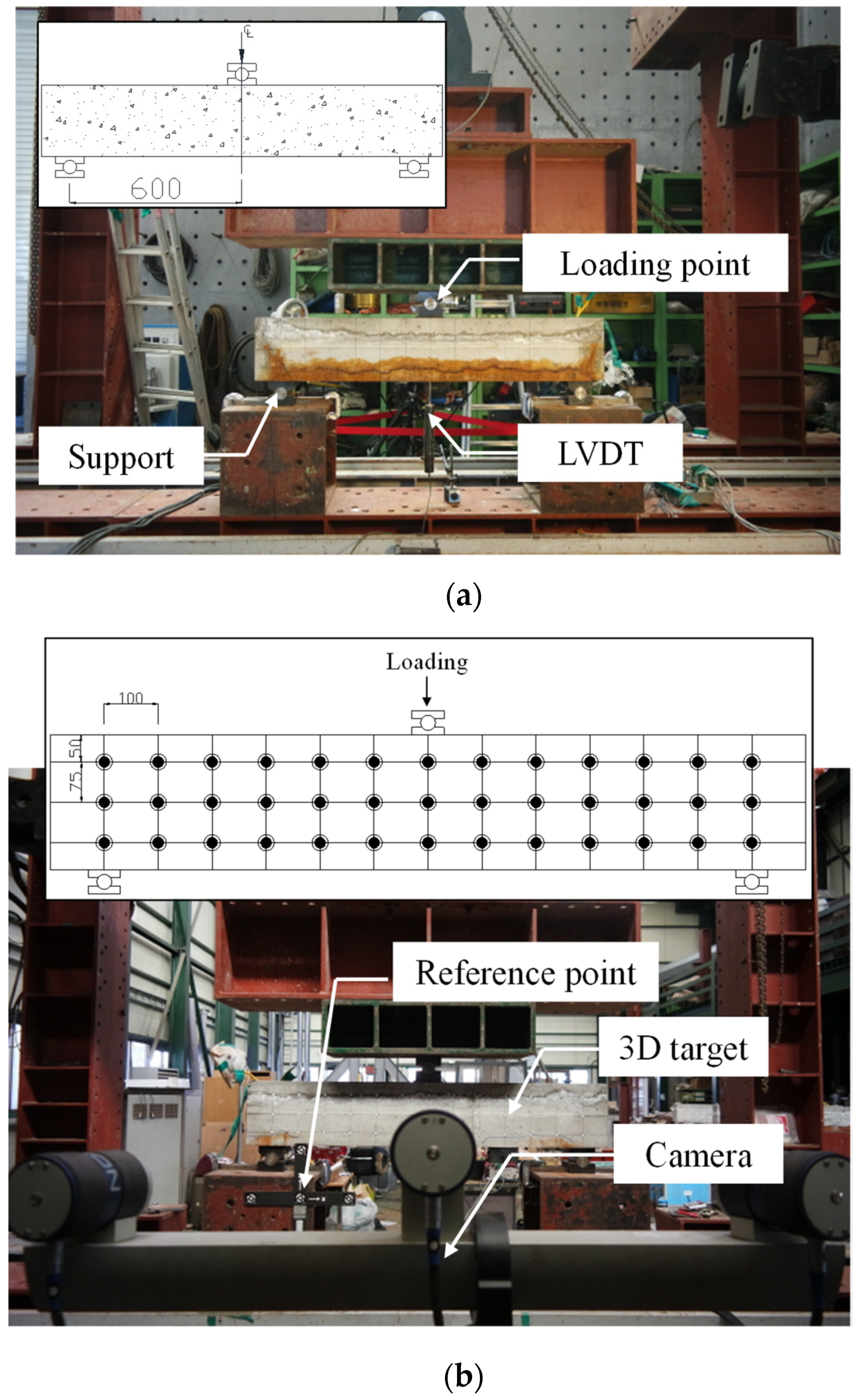
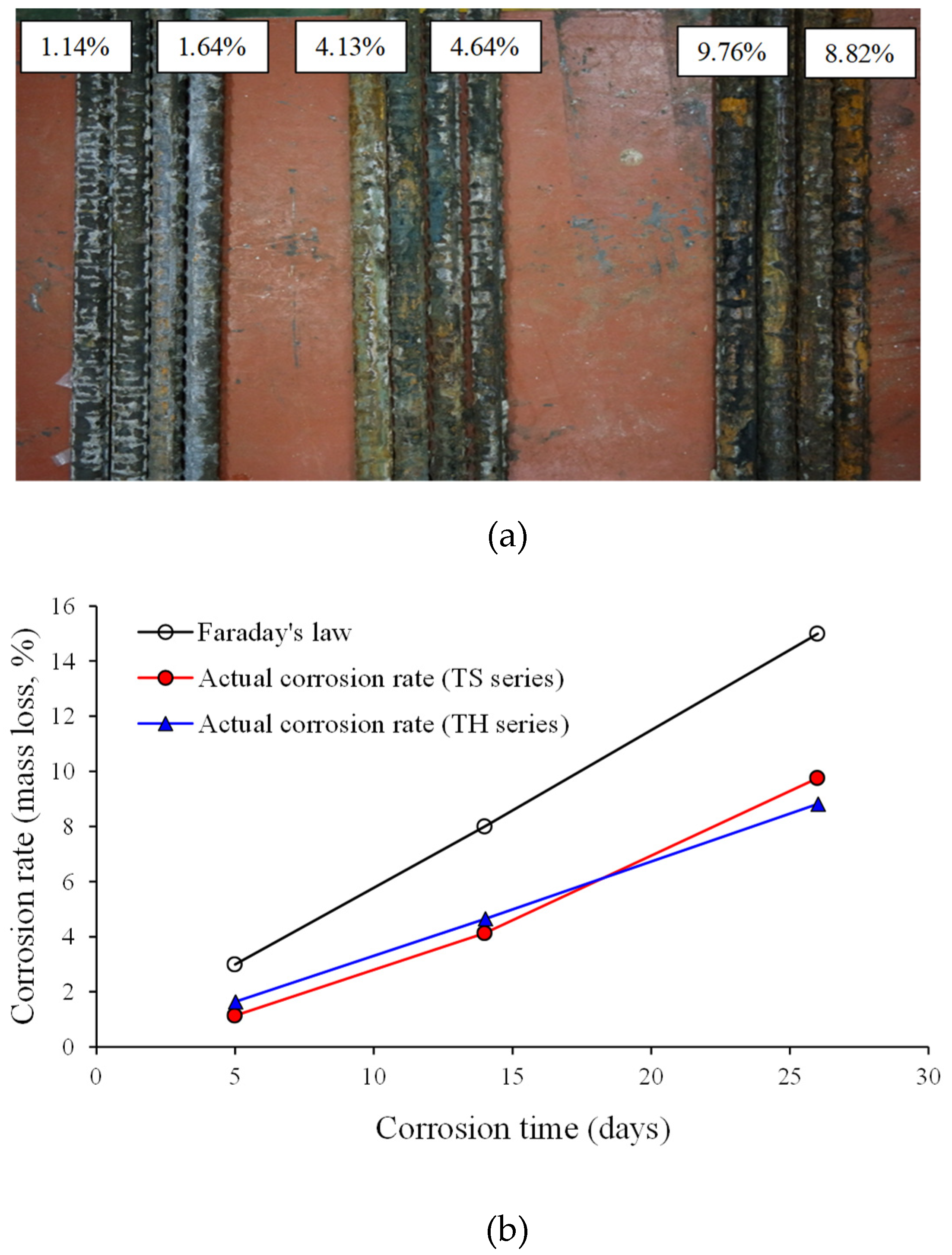
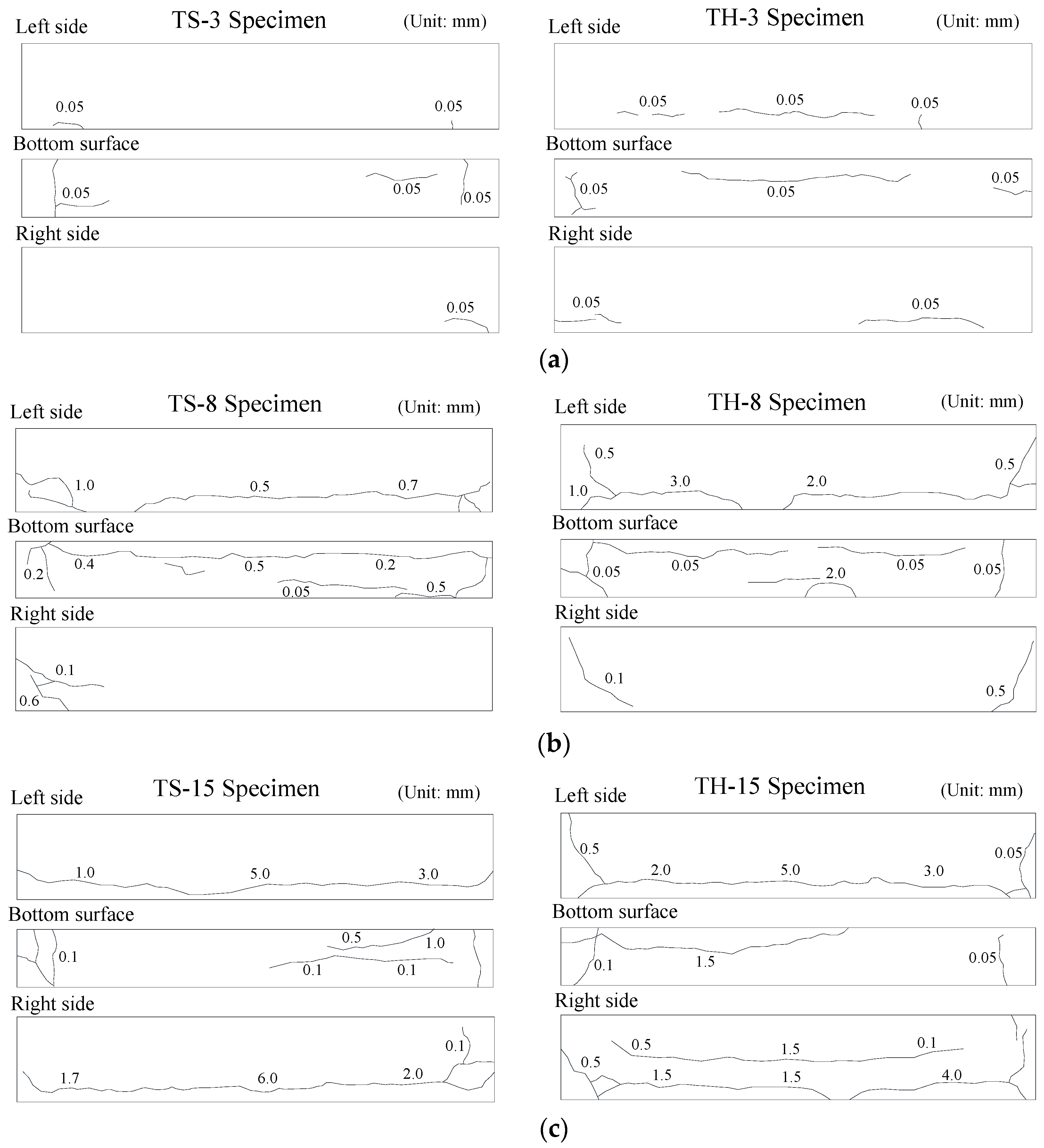
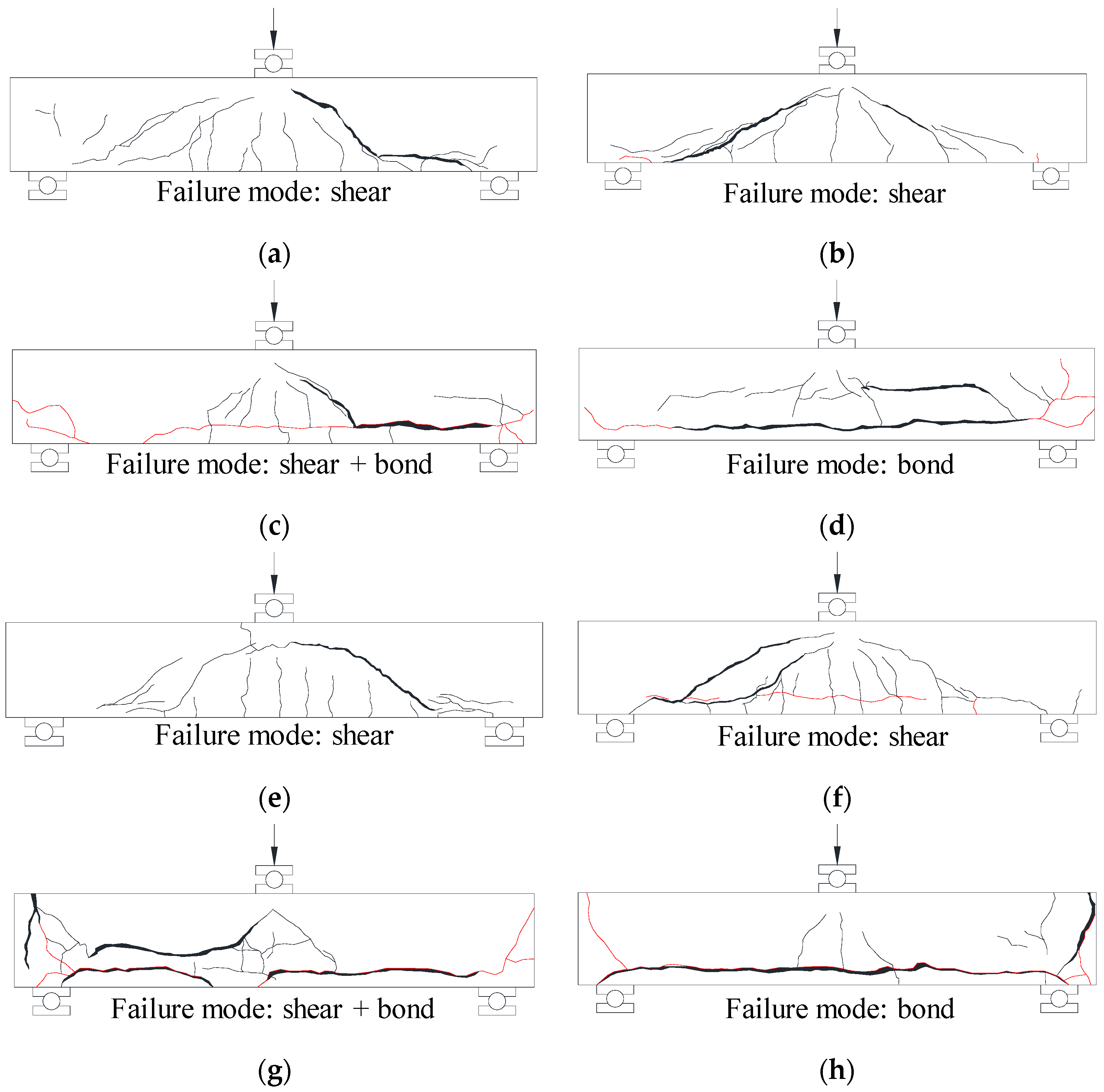

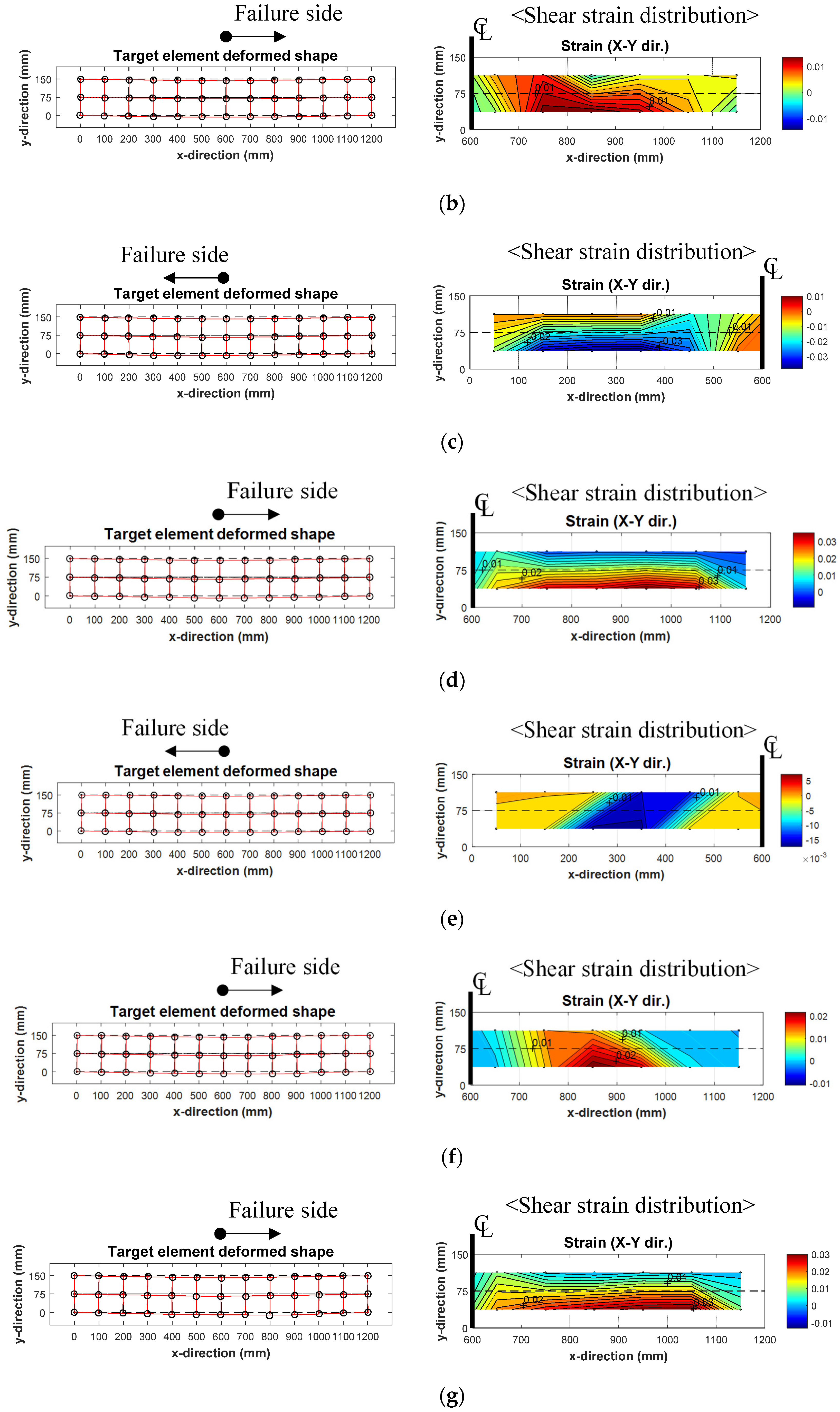

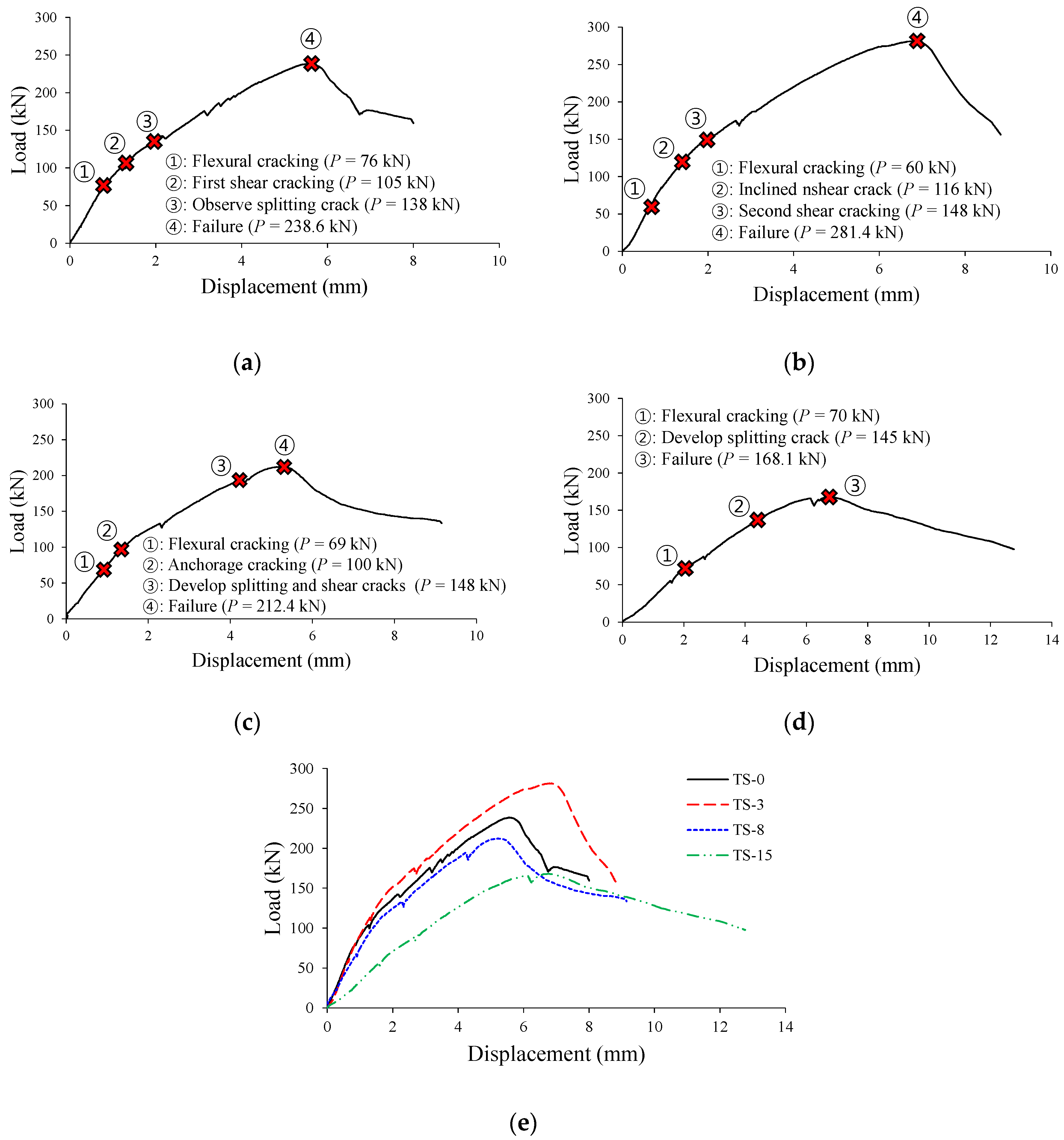
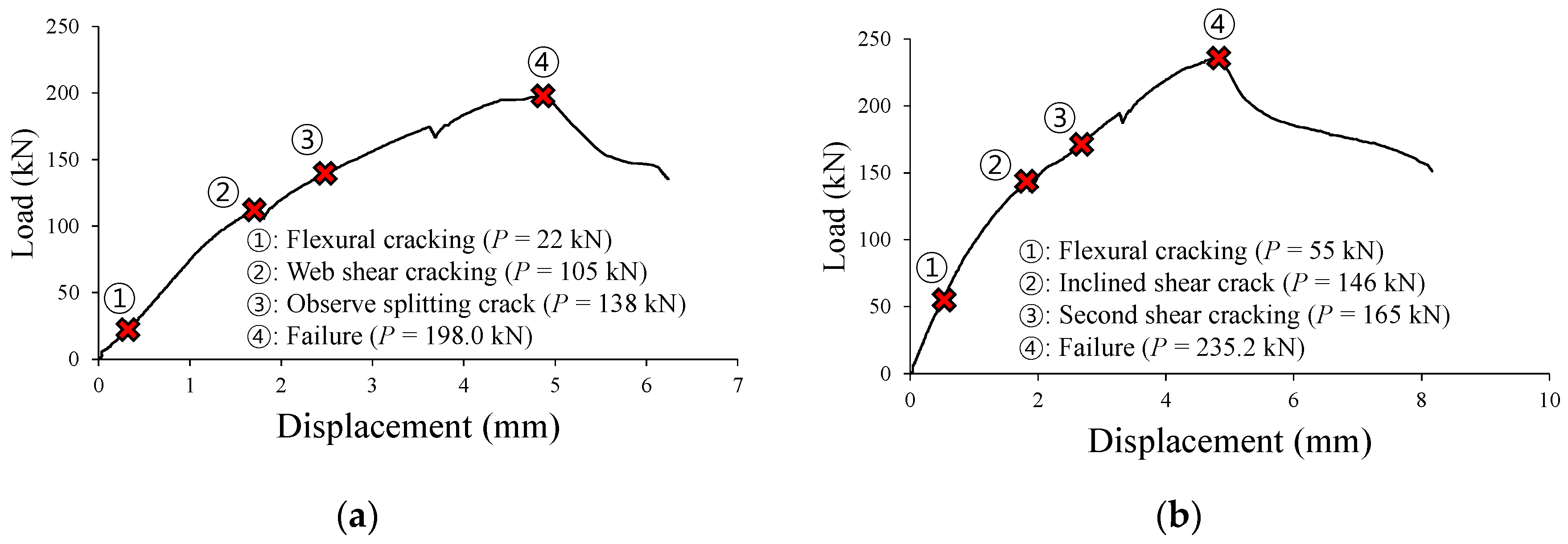
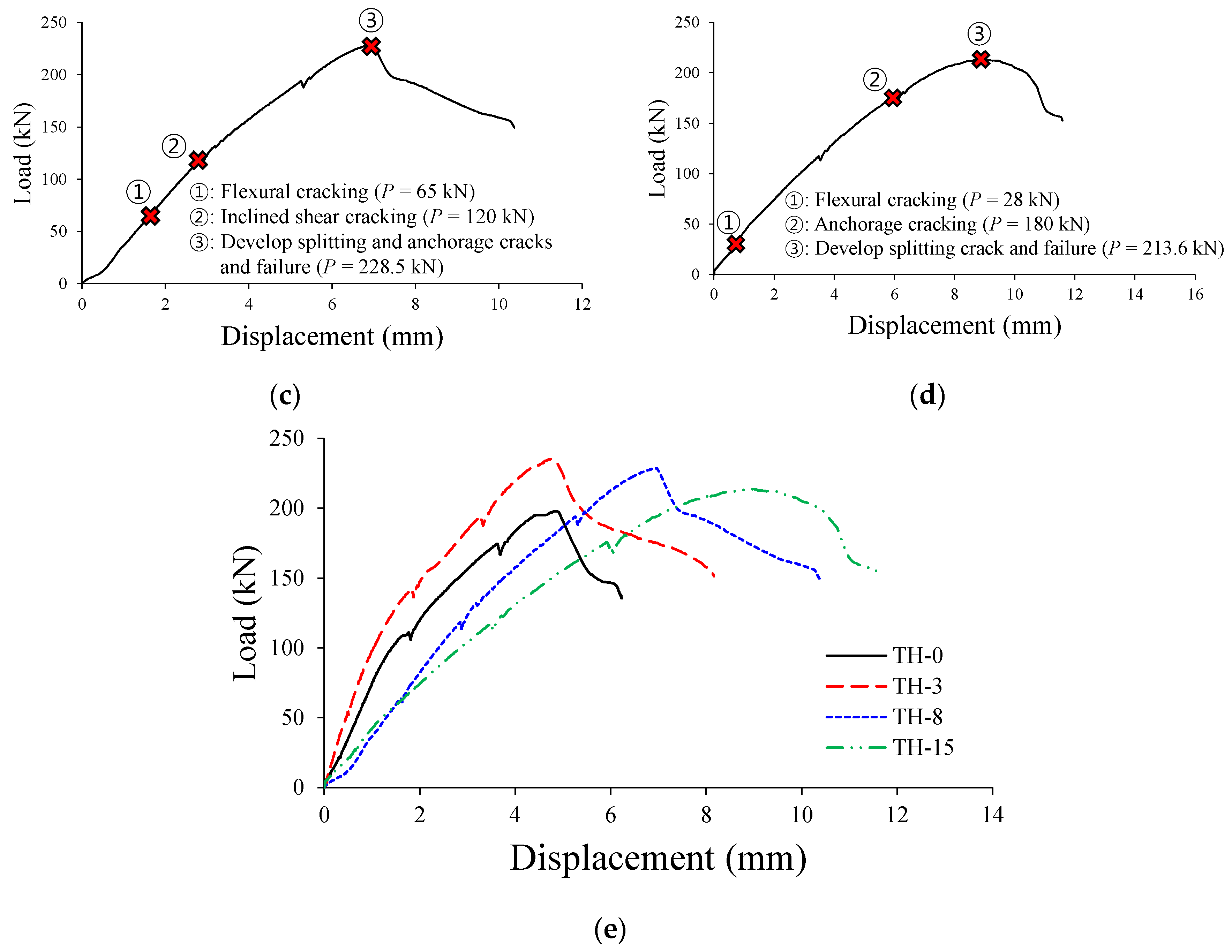
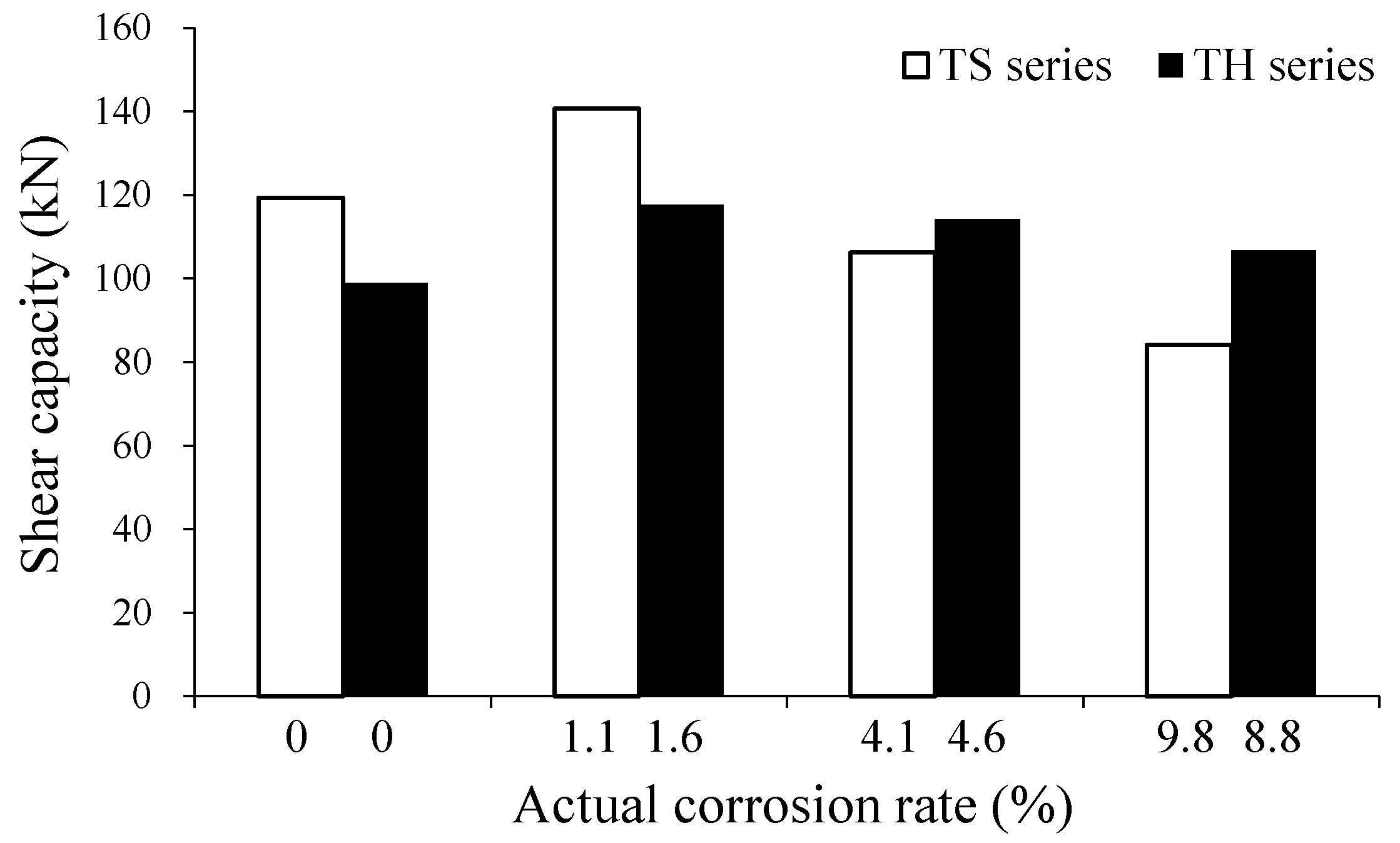
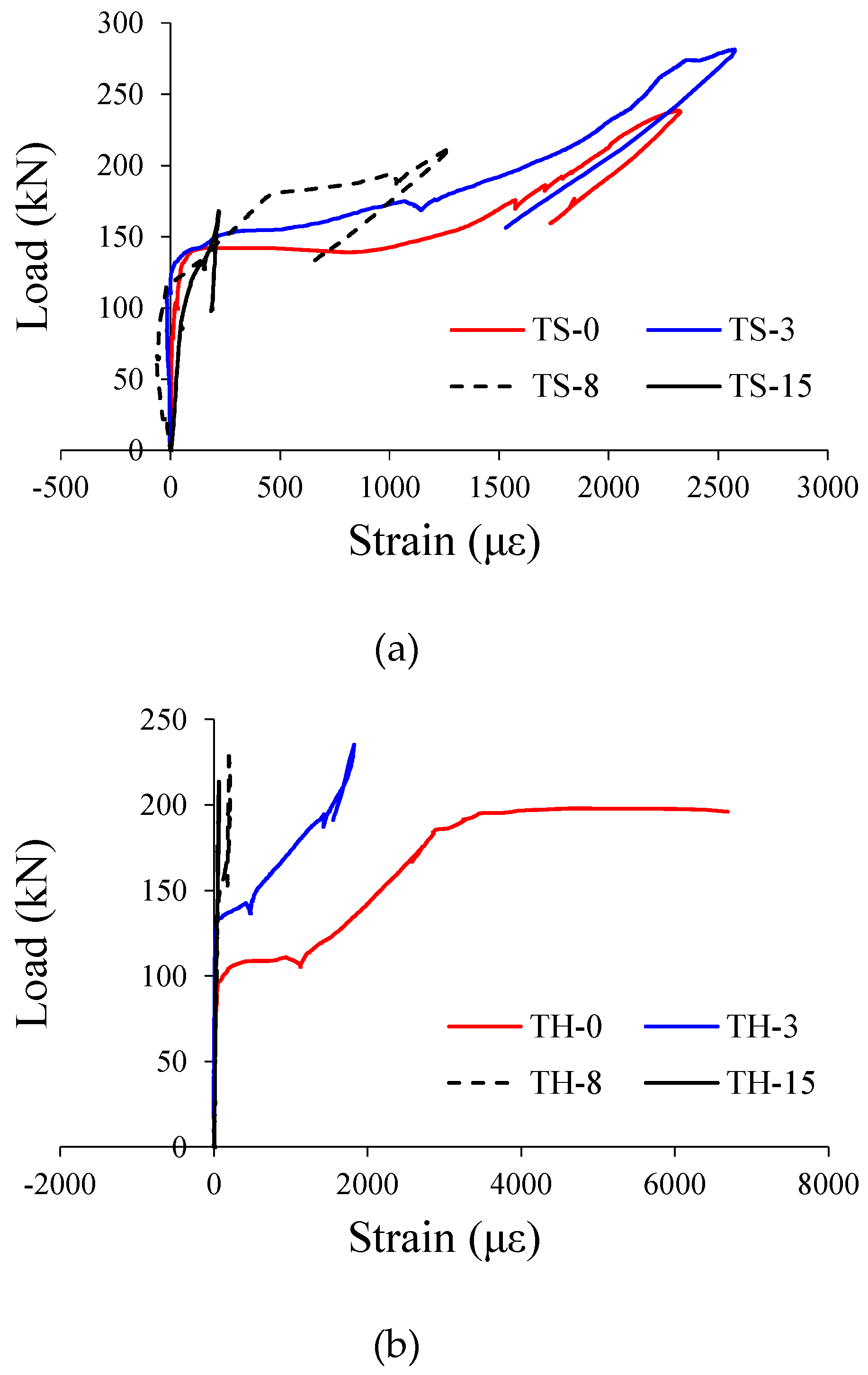
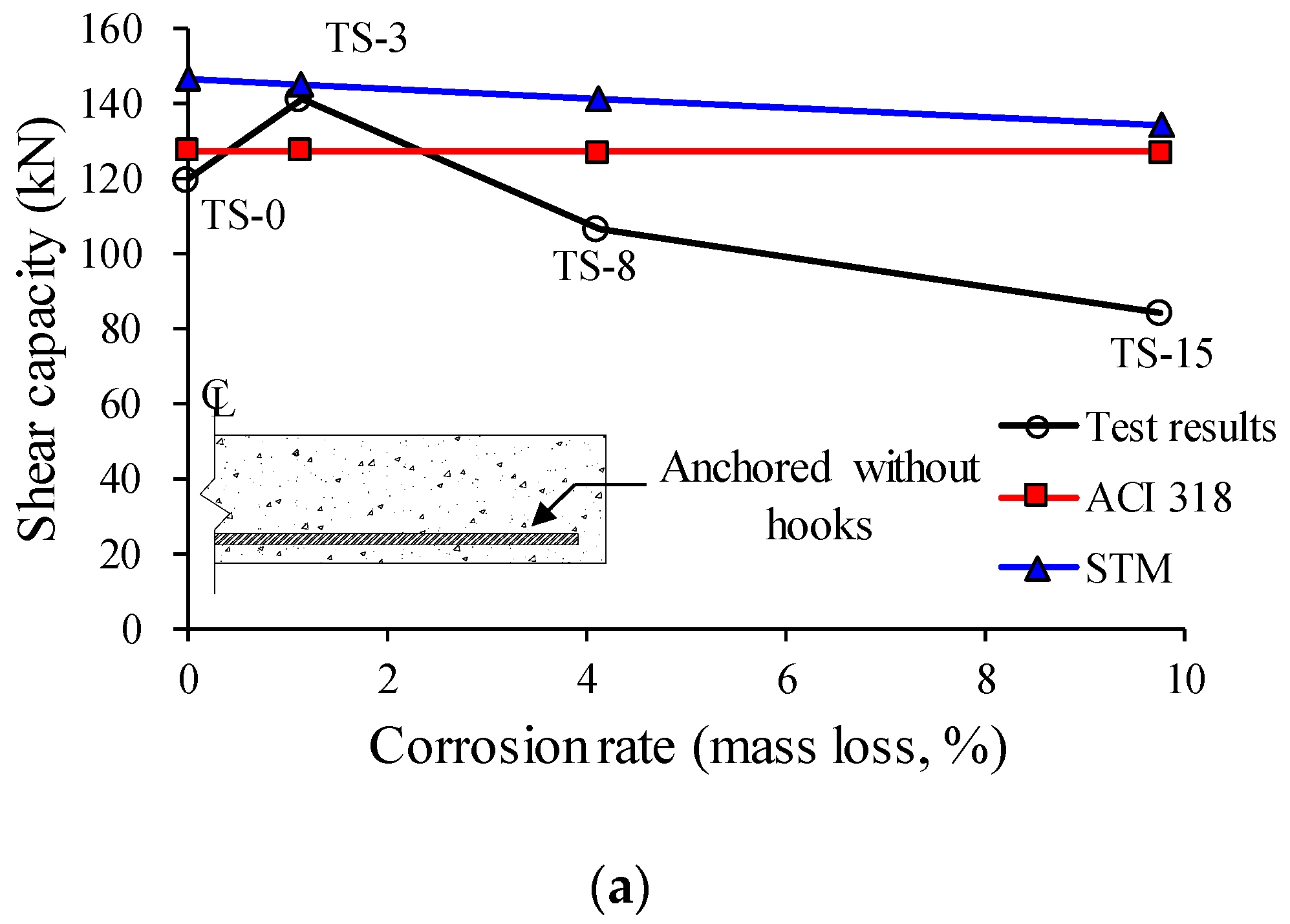
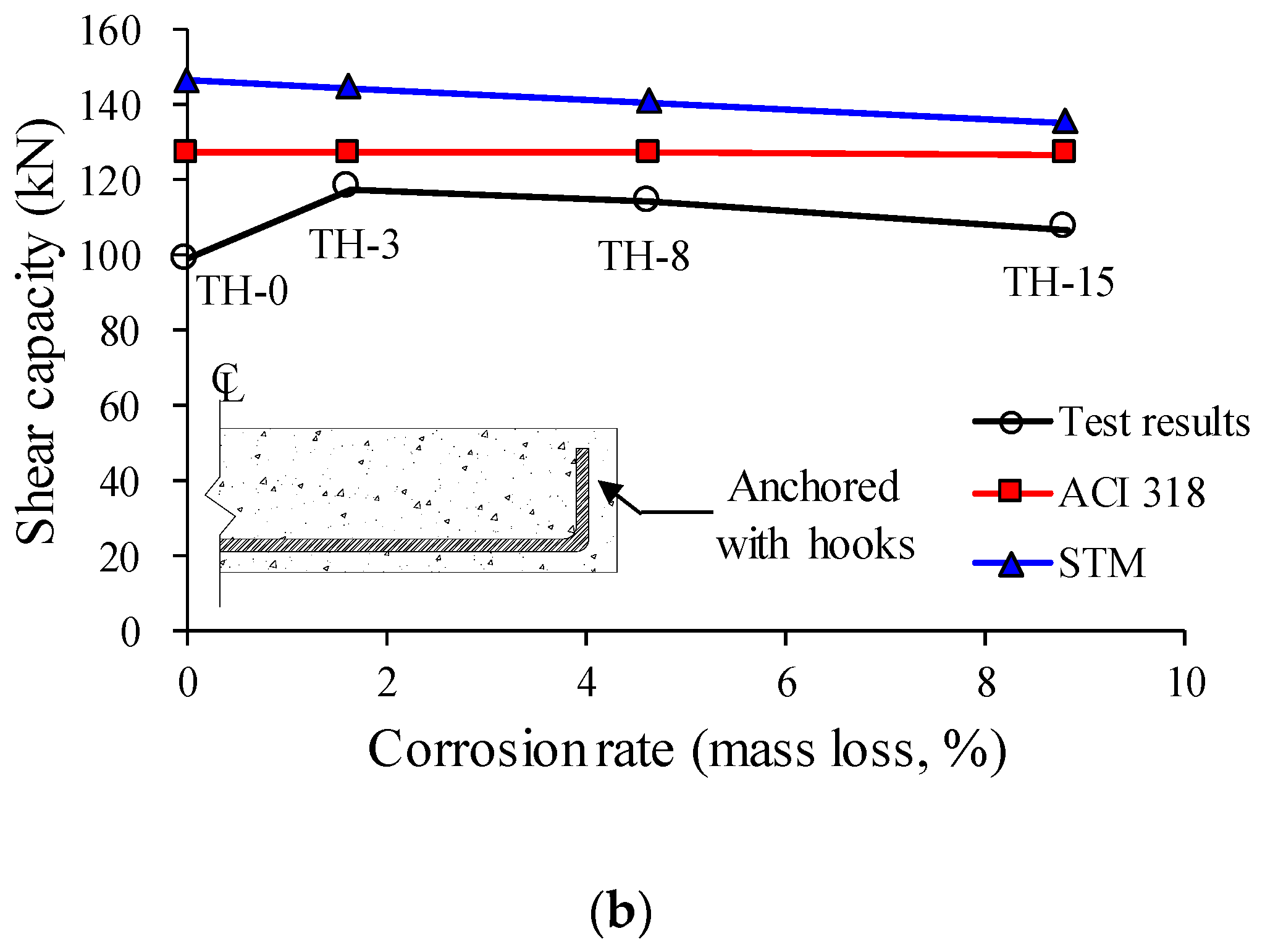
| Specimens | bw | h | ds | As | Av | sv | C | fc′ | fy | fvy | a/ds | ωcorr |
|---|---|---|---|---|---|---|---|---|---|---|---|---|
| (mm) | (mm) | (mm) | (mm2) | (mm2) | (mm) | (mm) | (MPa) | (MPa) | (MPa) | (%) | ||
| TS-0/TH-0 * | 170 | 250 | 210 | 845.5 | 71.3 | 100 | 30 | 56.3 | 635 | 534 | 2.86 | 0 |
| TS-3/TH-3 * | 3 | |||||||||||
| TS-8/TH-8 * | 8 | |||||||||||
| TS-15/TH-15 * | 15 |
| Specimen | Before Corrosion (g) | After Corrosion (g) | Mass Loss (g) | Corrosion Rate (%) | |||||
|---|---|---|---|---|---|---|---|---|---|
| Bar 1 | Bar 2 | Bar 1 | Bar 2 | Bar 1 | Bar 2 | Bar 1 | Bar 2 | Average | |
| TS-3 | 3803.9 | 3785.3 | 3759.7 | 3742.7 | 44.2 | 42.6 | 1.16 | 1.13 | 1.14 |
| TS-8 | 3809.1 | 3847.1 | 3689.1 | 3650.5 | 120.0 | 196.6 | 3.15 | 5.11 | 4.13 |
| TS-15 | 3856.3 | 3782.7 | 3406.9 | 3485.0 | 449.4 | 297.7 | 11.65 | 7.87 | 9.76 |
| TH-3 | 4619.9 | 4644.6 | 4540.4 | 4572.5 | 79.5 | 72.1 | 1.72 | 1.55 | 1.64 |
| TH-8 | 4631.6 | 4749.9 | 4462.9 | 4481.8 | 168.7 | 268.1 | 3.64 | 5.64 | 4.64 |
| TH-15 | 4750.9 | 4734.6 | 4357.6 | 4291.8 | 393.3 | 442.8 | 8.28 | 9.35 | 8.82 |
| Specimen | ωcorr (%) | Pn (kN) | Vn (kN) | ∆mid (mm) | Failure Mode | Strength Ratio * |
|---|---|---|---|---|---|---|
| TS-0 | 0 | 238.6 | 119.3 | 5.54 | Shear | 1.00 |
| TS-3 | 1.14 | 281.4 | 140.7 | 6.84 | Shear | 1.18 |
| TS-8 | 4.13 | 212.4 | 106.2 | 5.21 | Shear + bond | 0.89 |
| TS-15 | 9.76 | 168.1 | 84.1 | 6.76 | Bond | 0.70 |
| TH-0 | 0 | 198.0 | 99.0 | 4.82 | Shear | 1.00 |
| TH-3 | 1.64 | 235.2 | 117.6 | 4.74 | Shear | 1.19 |
| TH-8 | 4.64 | 228.5 | 114.3 | 6.94 | Shear + bond | 1.15 |
| TH-15 | 8.82 | 213.6 | 106.8 | 8.99 | Bond | 1.08 |
© 2019 by the authors. Licensee MDPI, Basel, Switzerland. This article is an open access article distributed under the terms and conditions of the Creative Commons Attribution (CC BY) license (http://creativecommons.org/licenses/by/4.0/).
Share and Cite
Han, S.-J.; Joo, H.-E.; Choi, S.-H.; Heo, I.; Kim, K.S.; Seo, S.-Y. Experimental Study on Shear Capacity of Reinforced Concrete Beams with Corroded Longitudinal Reinforcement. Materials 2019, 12, 837. https://doi.org/10.3390/ma12050837
Han S-J, Joo H-E, Choi S-H, Heo I, Kim KS, Seo S-Y. Experimental Study on Shear Capacity of Reinforced Concrete Beams with Corroded Longitudinal Reinforcement. Materials. 2019; 12(5):837. https://doi.org/10.3390/ma12050837
Chicago/Turabian StyleHan, Sun-Jin, Hyo-Eun Joo, Seung-Ho Choi, Inwook Heo, Kang Su Kim, and Soo-Yeon Seo. 2019. "Experimental Study on Shear Capacity of Reinforced Concrete Beams with Corroded Longitudinal Reinforcement" Materials 12, no. 5: 837. https://doi.org/10.3390/ma12050837
APA StyleHan, S.-J., Joo, H.-E., Choi, S.-H., Heo, I., Kim, K. S., & Seo, S.-Y. (2019). Experimental Study on Shear Capacity of Reinforced Concrete Beams with Corroded Longitudinal Reinforcement. Materials, 12(5), 837. https://doi.org/10.3390/ma12050837







